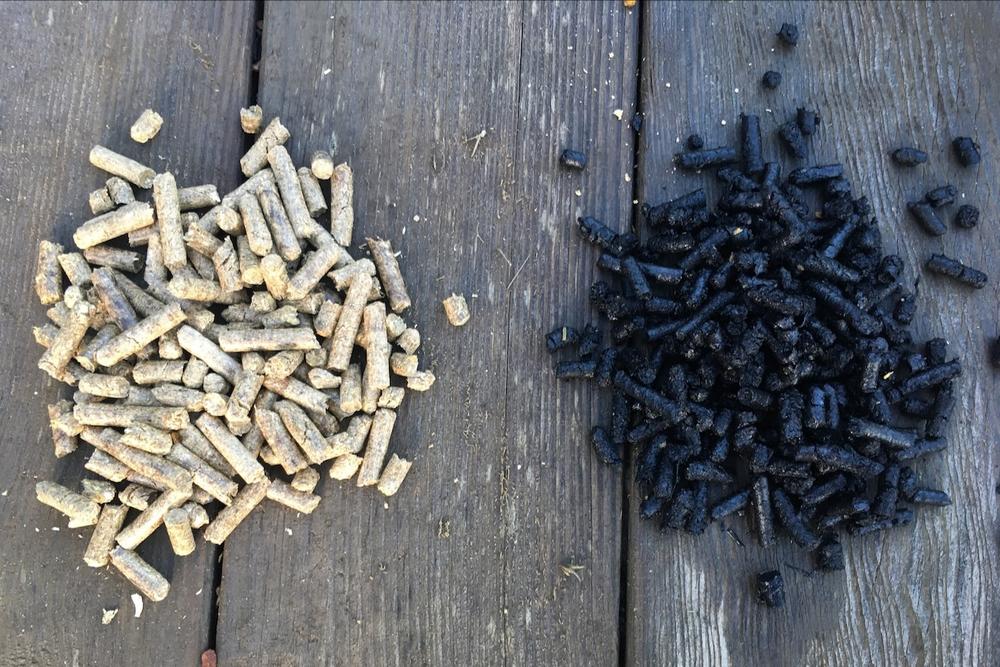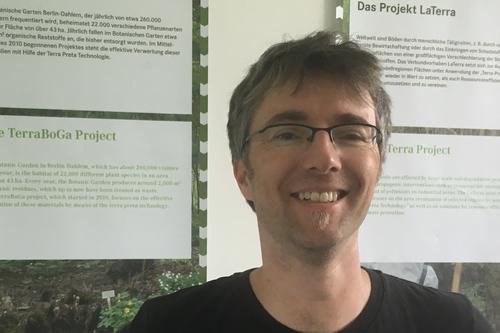When Life Gives You Biomass, Make Biochar
Turning biomass into biochar – geoecologist Robert Wagner has developed an eco-friendly concept that is ready for application
Aug 29, 2023
Biochar made from waste products could be used to reinvigorate soils or pave roads – and help us reduce our carbon footprint while doing so.
Image Credit: CarbonStoreAge / CarbonThink
One small rooftop terrace can produce an entire bucket of wilted flowers, leaves, and cuttings every week. So just imagine the amount of plant waste produced in the Botanic Garden or Berlin’s parks every year. Currently, the city of Berlin composts the plant waste it collects. However, the resulting compost is of very low quality and rarely fit for use. We need new ideas for dealing with plant waste, like the one proposed by Dr. Robert Wagner. He hopes to turn garden and plant waste into a high-quality product, which also generates heat in the process. The product? Biochar.
Wagner, a geoecologist at Freie Universität, has been pursuing possibilities since 2010. It all began with the idea of creating a closed-loop material cycle at the Botanic Garden. Earlier attempts to turn plant waste into good-quality, fertile soil through composting at the gardens had failed. In fact, this actually resulted in additional costs due to having to dispose of the poor-quality compost and purchase replacement fertilizer. But what if we could simply turn biomass into a high-carbon, nutrient-rich material and mix it into the soil for reuse? This is not a new concept. Indigenous people throughout the Amazonian basin have traditionally made use of terra preta (black earth) – a particularly dark, fertile soil enriched with compost and charcoal from cooking hearths – for hundreds of years.
The Benefits of Biochar
Inspired by this approach, the TerraBoGa project fired up its pyrolysis plant for the first time in 2013. “It is based on the traditional method used to create charcoal,” explains Wagner. “However, the process has been optimized. In modern pyrolysis plants, this can now take place in a very eco-friendly manner.”
The first stage in creating high-quality biochar involves drying the collected green waste and branches. Wood waste is then chopped into wood chips, and green waste is pressed into pellets or briquettes. “At TerraBoGa, we had a sort of kiln made from two tons of firebricks. Running through this stove was a long, hermetically sealed tube and an auger, which was used to feed the biomass through the kiln.” The process is simple: wood chips or pellets go in the front, they are heated to 450–600°C, and they come out as biochar.
Grinding up biochar, mixing it with compost, and adding it to the soil has many benefits. “Biochar is very porous. This means it has a large inner surface area that can be more easily colonized by microorganisms and is optimal for storing nutrients,” says Wagner. “Biochar also stores moisture, increasing the soil’s ability to retain water while also helping to loosen the soil.” The process of creating biochar, carbonization, is also strongly exothermic. This means that it creates a surplus of energy, usually in the form of heat. “The heat produced by the carbonization process can be captured and fed into local heating networks,” says Wagner. This means that creating biochar not only produces a commercially viable, environmentally friendly product that can increase soil yields by up to fifteen percent (as shown in experiments with potatoes, tomatoes, lettuce, and strawberries), it also presents an alternative to burning fossil fuels. All this makes biochar a substance of great environmental and economic significance.
A Carbon Sink Superstar?
While Wagner’s work initially focused on creating environmentally friendly material cycles, another important aspect soon gained importance within the context of the ongoing climate debate. Plant waste that rots and is decomposed through microbial processes releases the carbon dioxide (CO2) these plants once fixed through photosynthesis. However, this is not the case with biochar. On the contrary – it can stabilize and fix carbon in the soil for centuries, potentially making it a very effective carbon sink.
Robert Wagner, researcher in the working group “Geoecology” at Freie Universität Berlin.
Image Credit: René Schatten
Wagner and his team have since had the opportunity to investigate and optimize carbonization and the practical applications of biochar in five different projects – including in Tierpark Berlin. With 160 hectares of landscaped grounds, Tierpark Berlin generates large amounts of tree cuttings, green waste, and solid animal waste. This can all be turned into biochar. The waste is pyrolyzed at temperatures between 400 and 900°C. “The higher the temperature, the longer the biochar is able to resist microbial decomposition,” says Wagner. “This does, however, reduce the yield somewhat. When carbonization is carried out at very high temperatures, the biomass releases more volatile matter.” One ton of fresh biomass generates approximately 250 kg biochar. In terms of dry mass, this means that the overall yield can be up to forty percent, depending on the quality of the biomass used.
However, biochar can be used for much more than soil revitalization – it also has applications in the construction industry. For example, it has already been used as an additive in asphalt, allowing for the construction of more sustainable roads, says Wagner. Concrete is another important potential area of application, where biochar could be used as a substitute for increasingly limited resources such as sand or cement. Furthermore, biochar can be used as a filtration material for the treatment of contaminants in wastewater and soil. “When made from high-quality wood, biochar can even be used as a feed additive or a medical product,” says Wagner. It is even possible to carbonize sewage sludge.
However, not all types of biomass are suitable for use as biochar, explains Wagner. Due to their high nitrogen content, vegetable waste is better put to use in biogas plants or composting facilities.
The Future of Carbonization
The scientists have now more or less finished their research. Now it is time to apply their findings to real-world applications. The Sustainability & Energy Management Unit at Freie Universität Berlin has tasked Wagner with carrying out a feasibility study on carbonization on campus. The Botanic Garden and the veterinary medicine campus in Düppel have been selected as suitable locations for the study: they produce plenty of biomass, offer enough space for the treatment plants, and they are connected to local heating networks into which the heat generated by the carbonization process could be fed. The team is already in contact with the Steglitz-Zehlendorf parks department (Grünflächenamt) to discuss also making use of wood waste created by park maintenance work.
Were pyrolysis plants to be set up at both of these locations, 2,500 tons of carbon dioxide equivalents could be saved annually. Not bad for a university that has set itself the goal of achieving climate neutrality. Even by the most conservative estimates, actively implementing the creation and application of biochar could save the city of Berlin at least 20,000 tons of CO2 equivalents. This is an estimate that only takes a few producers of biomass into consideration: the Tierpark Berlin, the various parks departments, tree nurseries, and the green waste collection services such as the Berliner Stadtreinigung (Berlin Waste Management, BSR). It does not take into account companies that work with organic products and need to dispose of products from food waste for example, like cacao bean shells. This means that, in reality, the amount of carbon that Berlin could save is probably much, much higher.
This article originally appeared in German in the Tagesspiegel newspaper supplement published by Freie Universität Berlin.


